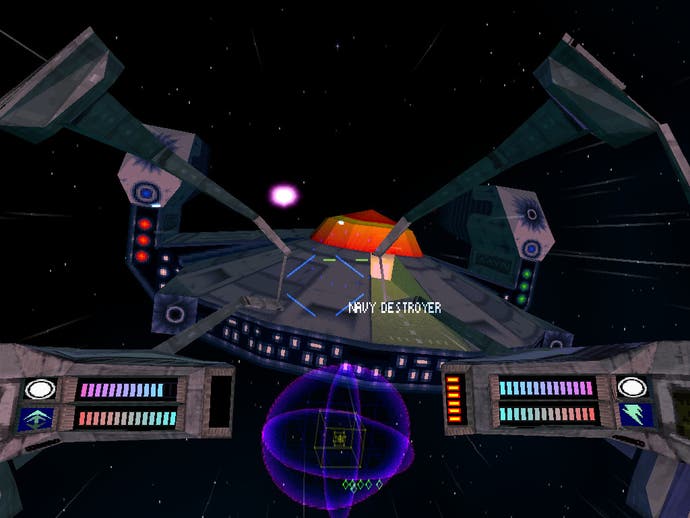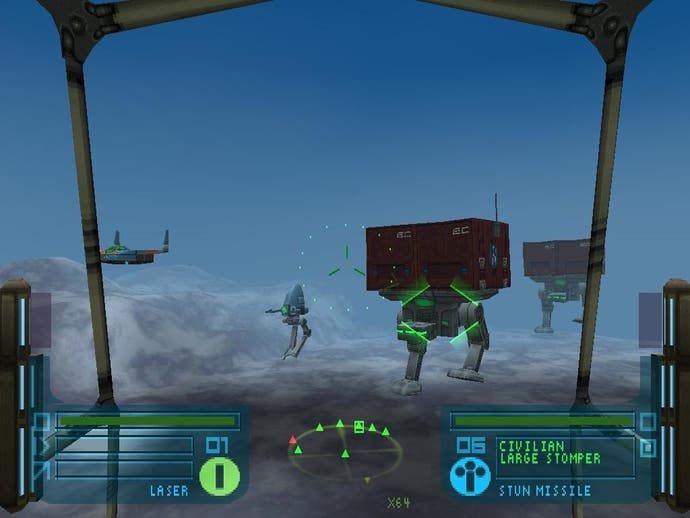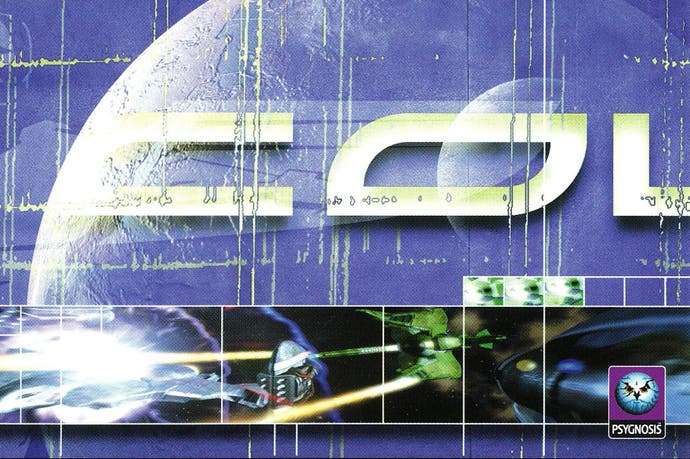What today's space sims can learn from Colony Wars
As No Man's Sky and Elite: Dangerous approach, we revisit Psygnosis's PS1 space opera.
I adore WipEout, but sometimes I think I'm most captivated by what isn't in it. Critics often observe that the franchise helped establish PlayStation as a brand by ingesting the sexier bits of 90s pop culture, seizing on them as furnishings for coruscating slipways of chevrons and weapons pads. It's a convincing line, but it also implies that WipEout's world and fiction are just edgy graffiti, a blaze of album cover iconography aimed at kids who were far too hip for the SNES and MegaDrive.
That's not how I saw it. As a teenager - very definitely not too hip for video games - I'd have paid no small amount of money for a game set beyond the track, in the cities that glint above every murderous chicane or plunging straight. Touring 2097's Gare D'Europa, I'd take potentially suicidal time-outs mid-drift to brood over billboards and the skybox. Who owns this blimp, cheekily posed at the top of the first ramp to remind you of an impending hard left? Where is that train going? And why does everybody in the future drink Red Bull? I'd tried the stuff and thought it tasted like deodorant. What did these trendy future-people know that I didn't?

Mind you, perhaps the point is not to know - both because anti-gravity racing demands your complete attention, and because a universe you actually experience can't help but fascinate less than one that's held out of reach. This also seems true of Psygnosis's other great science fiction opus, Colony Wars, a deft compromise between space flight sim and arcade dogfighter, released for PS1 in 1997. The two franchises couldn't be more different in most respects - WipEout's artistic debts are to glowsticks, trashy corporate motifs and bass you can feel through the soles of your feet, while Colony Wars is a big soppy love letter to George Lucas. But in hindsight, they both make dramatic play of the tension between what happens inside and outside the playable environment.
WipEout's claustrophobia stems mainly from its choice of genre, of course. With Colony Wars it seems like more of a technical problem - as graphics programmer Chris Roberts and other project veterans noted a few years ago in a Gamasutra post-mortem, fitting all those ships and effects into memory was a struggle, and part of the game's brilliance is how it turns this into an advantage. Colony Wars gives you the claustrophobia of being a speck in the murk, ignorant of what the wider black is about to throw at you. The sense of insignificance that ensues is reinforced by the branching storyline, which treats the player's nameless character as a cog in the machinery of interstellar war.
Often, the threats in question would be nothing more terrifying than a trio of Imperial Navy fighters - the missions are perhaps a little over-reliant on paltry shoot-outs with such flotsam, though the hefty handling ensures that even these routine encounters feel exhilarating. Every now and then, though, the tides of infinity would wash up bigger prey. Perhaps my favourite mission in the original game occurs early on, with the player defending a gigantic, faceted bauble of a starbase while engineers labour to close a wormhole. It's one of your first few tangles with a Navy cruiser - a fearsome perversion of the USS Enterprise, with its dish-shaped hull and pristine blue-white engine nacelles.

Lumbering into the middle of the combat zone, the cruiser proceeds to leak death from every hardpoint while you buzz around it, shaving away at its defences with lasers and missiles. When the interloper finally falls, the rewards are noisy and considerable. Light gouts through fault lines for a beat, just long enough for your jaw to drop, then the entire model puffs apart like an Airfix model tossed into a jacuzzi. Psygnosis was the graphical powerhouse of its era, even prior to its association with Sony, and few things speak to the studio's mastery of PS1's GPU like the spectacle of a capital ship biting dust in Colony Wars.
Linger for too long over the cruiser's fall, however, and you'll miss the bigger bang further afield. For a second or two, a nightmare out of Lovecraft can be seen inside the wormhole, a Cthulhu-esque anthill of discs, spokes and portholes. Then the dimensional chasm snaps shut, the approaching behemoth vanishes, and you're briefly surrounded by super-accelerated debris. "Warp hole has been closed," somebody chirrups from the space station, clearly amused by your discomfiture. "Navy Titan has been crushed."
Capital ships are the chthonic deities of Colony Wars, the monsters that go bump far off in the game's endless night. They aren't just there to blow you away, though - they're a means of anchoring players in desolate, direction-less play spaces. "One of the challenges with making games like this accessible is grounding the player in the environment," Chris Roberts told me by email (he's now technical director at Firesprite, a studio founded by Sony Liverpool veterans). "We always tried to give players a sense of 'up', so most of the large ships stuck to the same orientation in the same general XZ plane."

The same thinking applies to many of the game's supposedly cosmetic touches, such as the interstellar particles that fly like spray from your own ship's prow, or the way light and shadow travel across the beige fronds of your cockpit, with its cleanly laid-out shield and hull health bars. The Colony Wars team's most lasting achievement is perhaps how these scene-setting elements add up into something nerdily in-depth, yet intuitive. They pull off the minor miracle of making a featureless void seem negotiable and almost tangible, without resorting to the spidery numerical distance and orientation read-outs of an older sim.
The glory of the individual assets themselves has, of course, waned as graphics technology has advanced. Modern space sims don't have to worry quite as much about that barrier between play space and wider universe, either. Armed with the latest engines and several hundred times the RAM, interstellar epics like No Man's Sky and Elite: Dangerous can show us things older titles would only hint at: the inside of the space station you're defending, or the ocean fauna of a planet that in Colony Wars would have served merely as a navigator's handhold.
Still, if the developers of these projects aren't obliged by technology to hem their visions in, I hope they'll remain mindful of what games like Colony Wars achieved by keeping certain things at a tantalising remove. It's great that we can now explore entire, procedurally generated galaxies without a break in flow, but we need our horizons, our hard-to-traverse or even outright impassable regions, if exploration is to carry any sense of risk or drama at all.

